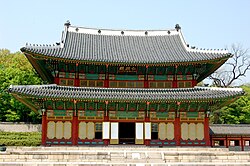Changdeok Palace
| Changdeokgung Palace Complex | |
|---|---|
| Name as inscribed on the World Heritage List | |

Changdeokgung Injeongjeon
|
|
| Location | Republic of Korea |
| Type | Cultural |
| Criteria | II,III,IV |
| Reference | 816 |
| UNESCO region | Asia-Pacific |
| Inscription history | |
| Inscription | 1997 (21st Session) |
| Changdeokgung | |
| Hangul | |
|---|---|
| Hanja | |
| Revised Romanization | Changdeokgung |
| McCune–Reischauer | Ch'angdŏkkung |
Changdeokgung (Hangul, 창덕궁, 昌德宮; literally, "Prospering Virtue Palace"), also known as Changdeokgung Palace or Changdeok Palace, is set within a large park in Jongno-gu, Seoul, South Korea. It is one of the "Five Grand Palaces" built by the kings of the Joseon Dynasty (1392–1897). As it is located east of Gyeongbok Palace, Changdeokgung—along with Changgyeonggung—is also referred to as the "East Palace" (동궐, 東闕, Donggwol).
Changdeokgung was the most favored palace of many Joseon princes and retained many elements dating from the Three Kingdoms of Korea period that were not incorporated in the more contemporary Gyeongbokgung. One such element is the fact that the buildings of Changdeokgung blend with the natural topography of the site instead of imposing themselves upon it. It, like the other Five Grand Palaces in Seoul, was heavily damaged during the Japanese occupation of Korea (1910–1945). Currently, only about 30% of the pre-Japanese structures survive.
Changdeokgung was the second palace after Gyeongbokgung which had been established in 1395 as a primary palace. In the midst of strife for the throne between princes and vassals, authority of Gyeongbokgung was deteriorated. King Jeongjong enthroned by Prince Jeong-an (Yi Bang-won, later became King Taejong) moved the capital to Gaegyeong, the one of Goryeo Dynasty, again in 1400 on the pretext of superior geographical features of it, in fact, in order to avert the power struggle. King Taejong (Yi Bang-won) soon taking over the throne returned to Hanseong(present-day Seoul) had a new palace named Changdeokgung instead of Gyeongbokgung because he had killed his half brothers in Gyeongbokgung whose construction was led by Jeong Do-jeon, the king's rival before. Construction of Changdeok Palace began in 1405, and was completed in 1412. King Seonjo expanded the palace grounds by about 500,000 square meters, including Huwon (see below).
...
Wikipedia
